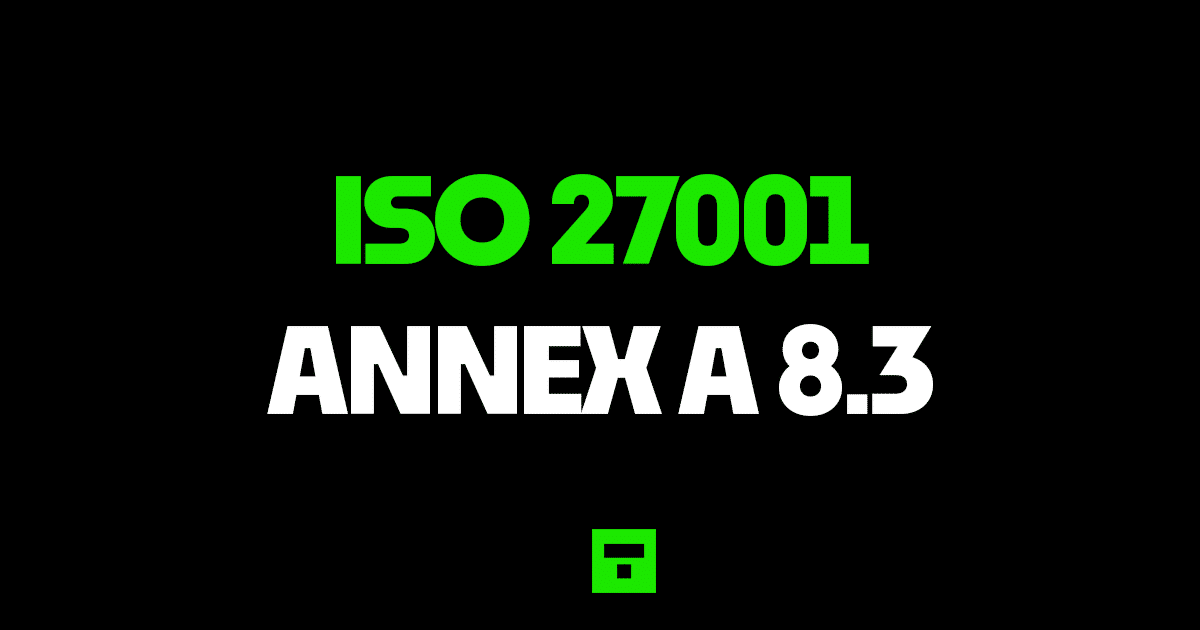ISO 27001 Information Access Restrictions
I am going to show you what ISO 27001 Annex A 8.3 Information Access Restriction is, what’s new, give you ISO 27001 templates, show you examples, do a walkthrough and show you how to implement it.
I show you exactly what changed in the ISO 27001:2022 update and exactly what you need to do for ISO 27001 certification.
Table of Contents
What is ISO 27001 Annex A 8.3?
ISO 27001 Annex A 8.3 Information Access Restriction is an ISO 27001 control that looks to make sure you have controls in place to restrict access to information based on risk and organisation need.
Purpose
The purpose of ISO 27001 Annex A 8.3 Information Access Restriction is to ensure only authorised access and to prevent unauthorised access to information and other associated assets.
Definition
The ISO 27001 standard defines ISO 27001 Annex A 8.3 as:
Access to information and other associated assets should be restricted in accordance with the established topic-specific policy on access control.
ISO27001:2022 Annex A 8.3 Information Access Restriction
Implementation Guide
This is not the Wild West so we do not allow everyone to have access to everything. A basic premise of information security is access. We protect what is important to us and only allow those that we want to have access to it, to have access to it.
Topic Specific Policy
Your starting point for this control is to implement a topic specific policy on access control and include in that policy your approach to access. The ISO 27001 Access Control Policy Template is already written for you and ready to go and includes a great free Access Control Policy Example PDF. There is a lot more information on the Access Control Policy including how to write your own is covered in ISO 27001 Access Control Policy Ultimate Guide.
We are not talking here about privilege access which we covered in 8.2 Privilege Access but we are looking more general.
Relevant Controls
Relevant Annex A controls here include:
ISO 27001 Access Rights – Annex A 5.18
ISO 27001 Access Control – Annex A 5.15
Dynamic Access
The control is not particularly hard. It is mainly common sense. The standard talks a lot about dynamic access management techniques, which I think is phrase they are hoping catches on. It is mainly about second guessing dynamic changes that require access control considerations. Situations like sharing externally, or when investigations occur, or sharing externally.
Information Classification
You can take into account the information classification scheme when you are working out what your access requirements are.
Technical Controls
The controls are mainly technical once you have the policy and the requirements. Authentication technology, credentials, or certificates to access information. Time based access that allows access for or in set times. The encryption for protecting information either at the device or information level. Setting out what the printing permissions are if appropriate.
Records
There will be consideration for recording access, monitoring, reporting and alerting.
Information access restrictions have been around a long time and there is nothing to worry about here.
ISO 27001 Templates
ISO 27001 templates have the advantage of being a massive boost that can save time and money so before we get into the implementation guide we consider these pre written templates that will sky rocket your implementation. This ISO 27001 Toolkit has been specifically designed so you can DIY your ISO 27001 certification, build your ISMS in a week and be ISO 27001 certification ready in 30 days.
DO IT YOURSELF ISO 27001
All the templates, tools, support and knowledge you need to do it yourself.
How to pass an audit
Time needed: 1 day
How to comply with ISO 27001 Annex A 8.3
- Have policies and procedures in place
Write, approve, implement and communicate the documentation required for information access restriction.
- Assess your access requirements and perform a risk assessment
Have an asset management process that includes an asset register. For each asset type perform a risk assessment and access requirements review.
- Implement controls proportionate to the risk posed
Based on the risk assessment implement the appropriate controls to mitigate the risk.
- Keep records
For audit purposes you will keep records. Examples of the records to keep include changes, updates, monitoring, review and audits.
- Test the controls that you have to make sure they are working
Perform internal audits that include the testing of the controls to ensure that they are working.
Top 3 Mistakes People Make
The top 3 mistakes people make for ISO 27001 Annex A 8.3 are
1. Not restricting access when people leave
Having a robust starter, leaver, mover process that accounts for leavers and considers the access restrictions during the notice period as well as when the person leaves is key. This is often overlooked with people having full access during notice and often the access still being in place when they leave.
2. Not matching your classification policy
The access policy and the classification policy set out what you do, not how you do it. Often there is an mis match with what actually happens. Consider approaches like role based access that allow you to define the access restriction requirements and then monitor, report and audit against it.
3. Your document and version control is wrong
Keeping your document version control up to date, making sure that version numbers match where used, having a review evidenced in the last 12 months, having documents that have no comments in are all good practices.
ISO 27001 Controls and Attribute Values
| Control type | Information security properties | Cybersecurity concepts | Operational capabilities | Security domains |
|---|---|---|---|---|
| Preventive | Confidentiality | Protect | Identity and access management | Protection |
| Integrity | ||||
| Availability |


